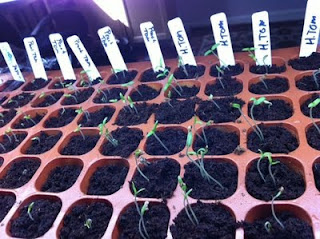
Zinnia on April 28
It was a big night in farm land - tonight, I decided that it was time to thin the seedlings. After a little bit of research, I decided on the snipping approach (as opposed to pulling), so that I wouldn't inadvertantly kill the remaining seedlings. I tried to make the decisions pretty carefully - keepers were straight seedlings, growing somewhere near the middle of their cell, with sturdy looking stems. Mike helped with some of the tough calls, and now we're down to one plant per cell. Except for the peppers - I'm going to give them a few extra days so that I can better see which seedlings are going to look the hardiest.


(Top picture - tomatoes post-thinning. I think the bottom shot is pretty self-explanatory)
It's really easy to tell the different seedlings apart now that their true leaves are coming in - with the tomatoes and marigolds especially it's obvious what they're going to grow up to become.
 Marigold on April 28
Marigold on April 28 This weekend will be a big farming weekend - we have plans to meet with our neighbor/garden guru to talk garden plans and raised beds, and (fingers crossed), we might be able to have the area where the garden will go rototilled. Also, another neighbor is coming over to help us pull out some nasty wild rose bushes and stumps, which Mike is very excited for as it will entail the use of an excavator, and potentially a tractor.















